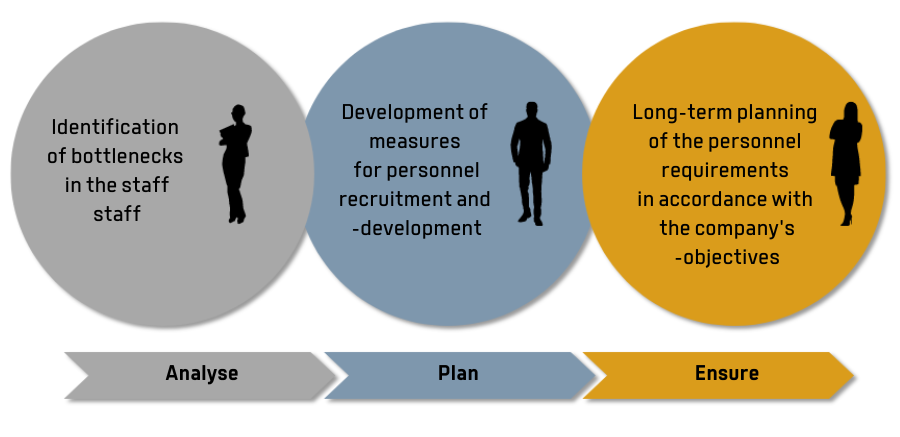10. Oktober 2023
Consequences of the shortage of skilled workers on project work
The shortage of skilled workers has now reached all companies. No industry is exempt. And this development will continue - at least according to the Federal Ministry for Economic Affairs and Climate Protection - in the coming years. The main cause is demographic change. According to the Institute for Employment Research (IAB), the German labour market could lose about seven million workers by 2035. Politicians and companies will certainly work to cushion these figures, but it is inevitable that companies will design their processes alongside them to deal with scarce (human) resources.

The challenge of resource planning
In continuous processes, such as production, the lack of resources can be quickly identified. In the best case, it can even be calculated in advance, as the output of the process depends on performance variables that can be clearly identified. The basis for this is usually the work plan, which defines work steps in combination of people and machines in terms of time. In projects, this is basically no different, but is usually only practised in a rudimentary way at best.
Probably the most widely used method: communicate the need for product development projects in advance to the implementing divisions. If necessary, this project portfolio is supplemented by the technology projects. From this, the departments draw up an estimate of how high the resource requirements are for their area in order to implement this portfolio. If there is a shortfall, it is clarified in dialogue whether it is possible to recruit new specialists and, if not, what effect this will have on the current and upcoming projects. Since a company rarely develops in a disruptive way, this approach based on continuous development was sufficient to ensure a balance between resource needs and entrepreneurial success.
Planning approaches with weaknesses
But even this approach had weaknesses, as in many cases only the sum of resources over a planning period - usually a year - was considered. The concrete time requirements in a month or even a week were not determined. During the implementation of the projects, however, this often became a stumbling block, because the demand for certain specialists in certain periods accumulated. The result was a bottleneck that led to delays in individual projects.
From the practice of our consultancy projects, we know that the accumulation of such cases can certainly lead to considerable delays in individual or even almost all projects. The effect is often underestimated and rarely measured correctly. But if you talk to the people concerned at the working level, it is precisely the day-to-day displacement processes that lead to missed deadlines. Another effect that leads to problems in the processing of projects: newly recruited employees - even if they are quite qualified - do not immediately perform to their full potential. The familiarisation as well as the introduction to the special company-specific matter takes time, which is often not taken into account when calculating the resource requirements.
Skilled labour shortage leads to non-linear effects
In the future, these planning approaches will no longer be sufficient to process a portfolio of projects on schedule. There are several reasons for this:
Simply carrying on like this is not the solution
Based on this, a worst-case scenario emerges. The projects get so out of hand in all three target dimensions (costs, quality and time) that the entrepreneurial goals are seriously endangered. Most companies therefore know: simply carrying on like this is not an option!
Three levers can be used to counter the shortage of skilled workers:
- Consideration in the corporate strategy
- Long-term personnel planning
- Structured project portfolio planning
Considering the shortage of skilled workers in the corporate strategy
Focus is the key word of the future. Companies must focus on the business areas or the products that have a key position for the company's success. Too often, "nice to have" positions are considered in the portfolio. Apart from the fact that these positions also require management attention, they also pull resources away from core projects. This competitive situation should be avoided in the approach.
Set up long-term and strategic personnel planning
A shortage of skilled workers is a human resources issue. Since this shortage can seriously jeopardise a company's growth, human resource planning must become more important. Starting with the question of how the company can present itself more attractively to skilled workers, to the dialogue with people who are of retirement age, to the business consideration of prolonged double staffing in positions where experience bearers are sitting who will leave the company in the near future. It is highly recommended that the company management declares human resource planning a strategic issue and helps to shape it intensively.
Decide and work through the project portfolio in a structured way
In our previous CO Improve newsletter, we presented our approach to efficient project portfolio management. The bottom line is that both the decision on which project to implement and the operational management of projects need to be more structured. This structure requires more effort from a managerial point of view, but it pays off later. With control at a deeper level of detail, many effects, such as the experience gap of new employees, can be taken into account much better. It is worth investing in this process. In the end, it is ensured that the projects that are important for the company are completed on time, on budget and on quality.
Preventing the shortage of skilled workers in good time
It is obvious that the shortage of skilled workers will affect all companies. There are many possible solutions. But the idea that in the end everything will remain as before is an illusion. The time to prepare adequately has long since begun. Our experienced consultants can support you in planning and implementing the right measures for your company.
Your benefit
- The consequences of the shortage of skilled workers on project work are cushioned
- Product development projects are implemented in a focused manner


